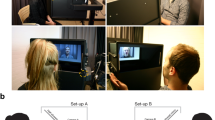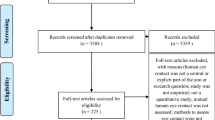Abstract
The influences of sex, age, and conversational, partner (mother vs. stranger) on eye contact during verbalizations were examined in a longitudinal study of 33 children at 2 and 4 years of age. A free-play sample was obtained of each child interacting with mother and with a male or female experimenter. The amount of eye contact in conjunction with verbalization was analyzed. Significant main effects were found for sex (females engaged in a higher percent of eye contact than males) and conversational partner (more eye contact while speaking exhibited to experimenter than to mother). There was an interaction between age and conversational partner, in that mother received more and experimenter relatively less percent of eye contact during verbalizations as children got older. Notably, there was no main effect for age. These results revealed sex differences at an age (2–2 1/2 years) and in a context (free-play setting) not previously studied, demonstrating the robustness of the effect. Further, age findings seem indicative of unique developmental trends for eye contact during verbalizations for the ages between 2 and 4 years.
Similar content being viewed by others
References
Ashear, V., & Snortum, J.R. (1971). Eye contact in children as a function of age, sex, social and intellective variables.Developmental Psychology, 3, 479.
Cherry, L., & Lewis, M. (1976). Mothers and two-year-olds: A study of sex differentiated aspects of verbal interaction.Developmental Psychology, 12, 278–282.
Clarke-Stewart, A. (1973). Interactions between mothers and their young children: Characteristics and consequences.Monographs of the Society for Research in Child Development,38, (No. 153).
Cohen, J. (1968). Weighted Kappa: Nominal scale agreement with provision for scaled disagreement or partial credit.Psychological Bulletin, 70, 213–220.
Duncan, S. (1969). Nonverbal communication.Psychological Bulletin, 72, 118–137.
Endsley, R.C., Hutcherson, M.A., Garner, A.P., & Martin, M.J. (1979). Interrelationships among selected maternal behaviors, authoritarianism, and preschool children's verbal and nonverbal curiosity.Child Development, 50, 331–339.
Furrow, D. (1984). Social and private speech at two years.Child Development, 55, 355–362.
Goffman, E. (1963).Behavior in public places. Glencoe, Illinois: Free Press.
Hittelman, J.H., & Dickes, R. (1979). Sex differences in neonatal eye contact time.Merrill-Palmer Quarterly, 25, 171–184.
Imada, A.S., & Hakel, M.D. (1977). Influence of nonverbal communication and rater proximity on impressions and decisions in simulated employment interviews.Journal of Applied Psychology, 62, 295–300.
Kleinke, C.L., Desautels, M.S., & Knapp, B.E. (1977). Adult gaze and affective and visual responses of preschool children.Journal of Genetic Psychology, 131, 321–322.
Kleinke, C.L., Meeker, F.B., & LaFong, C. (1974). Effects of gaze, touch, and use of name on evaluation of “engaged” couples.Journal of Research in Personality, 7, 368–373.
Lasky, R.E., & Klein, R.E. (1979). The reactions of five-month-old infants to eye contact of the mother and of a stranger.Merrill-Palmer Quarterly, 25, 163–170.
Levine, M.H., & Sutton-Smith, B. (1973). Effects of age, sex, and task on visual behavior during dyadic interaction.Developmental Psychology, 9, 400–405.
Maccoby, E. E., & Jacklin, C.N. (1974).The psychology of sex differences Stanford: Stanford University Press.
Menn, L., & Boyce, S. (1982). Fundamental frequency and discourse, structure.Language and Speech, 25, 341–383.
Muirhead, R.D. & Goldman, M. (1979). Mutual eye contact as affected by seating position, sex, and age.Journal of Social Psychology, 109, 201–206.
Robson, K.S., Pedersen, F.A., & Moss, H.A. (1969). Developmental observations of diadic gazing in relation to the fear of strangers and social approach behavior.Child Development, 40, 889–896.
Russo, N.F. (1975). Eye contact, interpersonal distance, and equilibrium theory.Journal of Personality and Social Psychology, 31, 497–502.
Tomasello, M., Farrar, M. J., & Dines, J. (1984). Children's speech revisions for a familiar adult and an unfamiliar adult.Journal of Speech and Hearing Research, 27, 359–363.
Vaissiere, J. (1983). Language-independent prosodic features. In A. Cutler & D. R. Ladd (Eds.),Prosody: Models and measurements. New York: Springer-Verlag.
Vlietstra, A. G., & Manske, S. H. (1981). Looks to adults, preferences for adult males and females, and interpretations of an adult's gaze by preschool children.Merrill-Palmer Quarterly, 27, 31–41.
Wolff, P. H. (1963). Observations on the early development of smiling. In B.M. Foss (Ed.),Determinants of infant behavior (Vol. 2). London: Methuen.
Additional information
Mount Saint Vicent University
Rights and permissions
About this article
Cite this article
Podrouzek, W., Furrow, D. Preschoolers' use of eye contact while speaking: The influence of sex, age, and conversational partner. J Psycholinguist Res 17, 89–98 (1988). https://doi.org/10.1007/BF01067066
Accepted:
Issue Date:
DOI: https://doi.org/10.1007/BF01067066




